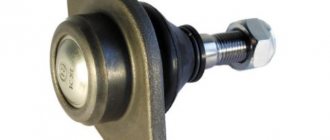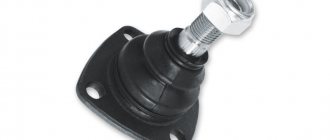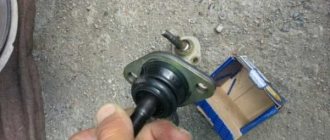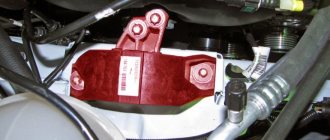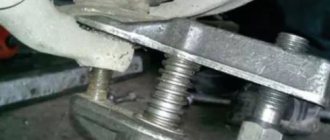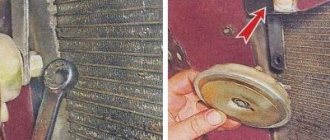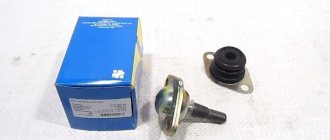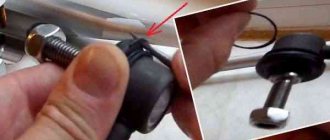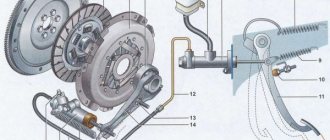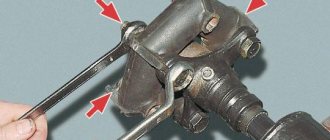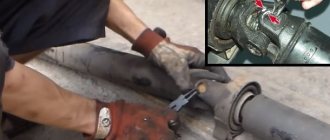Ball joints are an important and indispensable part of a car's suspension, which connects the suspension arms and wheel hubs. This makes it possible to rotate and simultaneously turn left and right.
Previously, the role of ball joints in a car was performed by a pivot mechanism, this was the case until approximately the 60s of the last century. But this mechanism had many disadvantages, namely:
- fragility;
- heavy weight;
- it had to be constantly lubricated;
- ability to work only in the horizontal plane.
Therefore, with the advent of “balls” they completely replaced the “pivot”. There are several options for the location of supports in a car - two on top and two below, or only two supports on the bottom of the front suspension. And there are rear supports, they are installed in front-wheel drive cars with independent rear suspension.
The front wheels are able to turn because the upper supports support the steering knuckle. Modern technologies have made it possible to develop ball joints with a long service life, but this only applies to original parts. Unfortunately, there are now many handicraft spare parts on sale that are not of high quality. Naturally, the original hinges also fail and the reason for the rather downtime is wear. It occurs due to the friction that is created by changing direction and driving on uneven roads. The more the car travels along a bumpy road and the more often it turns, the faster the wear will be.
Absence or insufficient lubrication, as well as dirt, can accelerate wear. In passenger cars, ball joints have a sealed housing; this solution avoids constant maintenance. Some manufacturers additionally equip the supports with grease fittings to make it possible to add lubricant. It is added with a special syringe and allows you to increase service life by reducing the friction of the finger inside the support body.
Ball pins with a sealed housing do not have grease fittings (grease nipples), this prevents dirt from getting inside. Low friction in such supports is achieved thanks to a backing made of synthetic material. This affects the handling, it becomes light and this option is more preferable for front-wheel drive models.
Purpose of ball joints VAZ 2107
A ball joint (BJ) is an ordinary hinge built into the VAZ 2107 suspension and allows the wheel to move only in a horizontal plane. At the same time, it limits the possibility of wheel movement in the vertical direction.
Ball joints on the latest versions of the VAZ 2107 have become more compact
Ball joints of the VAZ 2107 are very short-lived, so they have to be changed often.
Design of ball joints VAZ 2107
Previously, passenger cars did not have ball joints. They were replaced by bulky king pins that had to be lubricated frequently. The mobility of such compounds left much to be desired. This, in turn, negatively affected the car's handling. The designers of the VAZ 2107 abandoned the kingpins and installed ball joints. The first SHO consisted of:
- housings;
- ball pin;
- springs;
- anther
The finger was pressed into a fixed eye, fixed with a powerful spring and covered with a boot. This structure also needed to be lubricated periodically, but quite rarely (about twice a year). The lubricant on the pins had to be changed every week.
Modern ball joints do not use springs
Subsequently, the VAZ 2107 SHO was constantly improved:
- the spring disappeared from the structure;
- the steel boot was replaced with a plastic one;
- the fixed eyelet in which the finger was fixed became more compact and received a plastic external finish;
- SHOs have become non-separable, that is, practically disposable.
One driver I know assured me that he had found a great way to extend the life of plastic boots. Before installing new ball joints, he always applied a thick layer of silicone ointment to the boots, which car owners use to prevent the rubber bands on car doors from freezing in winter. From his words, it turned out that the anthers after such a procedure become practically “indestructible.” When I asked how an ointment intended for rubber could improve the quality of plastic, I was recommended to just try it and see for myself. Unfortunately, we never got around to it. So I leave it to the reader to check this driver’s find.
Reasons for failure of VAZ 2107 ball joints
The main reasons for SHO failure are as follows:
- Alternating shock load. As a result, the ball pin pressed into the suspension eye is destroyed. The support is designed in such a way that the shock loads on the pin ball are very high. When the quality of roads is poor, these loads increase manifold. In such conditions, even a high-quality SHO will not be able to fully exhaust its resource.
- Lack of lubrication. Under the influence of shock loads, the lubricant is gradually squeezed out of the SHO. In addition, over time, the lubricant loses its original properties.
- Anther destruction. The boot protects the hinge joint from dirt. If a crack appears in it, the dirt that gets into the joint turns into an abrasive material and grinds down the surface of the ball pin.
Dirt gets into the joint through a crack in the boot and wears down the surface of the ball pin.
Signs of malfunction of VAZ 2107 ball joints
The main symptoms of a VAZ 2107 SHO malfunction include:
- Extraneous sounds. While driving, a knocking or grinding noise begins to be heard from the wheel. This is especially pronounced on uneven roads at a speed of about 30 km/h and is usually a consequence of partial destruction of the ball on the support pin.
- Wheel rocking. When accelerating, the wheel begins to sway slightly in different directions. This happens due to the backlash that occurs in the SHO due to its wear. The situation is quite dangerous, and the backlash must be eliminated quickly. Otherwise, the wheel may turn at a right angle to the body at speed.
Play in the ball joint causes the front wheel to sway, which can spin out at speed. - Grinding and squeaking noise when turning the steering wheel left or right. The reason is the lack of lubrication in one of the SHOs (usually only one of the supports fails).
- Uneven wear on front and rear tires. This can happen not only due to faulty SHOs. The cause of uneven wear may be incorrectly adjusted camber and toe-in, insufficient or excessive air pressure in individual wheels, etc.
Auto repair school - Do-it-yourself car repair
May 24, 2016 VAZ 2101, VAZ 2102, VAZ 2105, VAZ 2106, VAZ 2107, Zhiguli, Classics by admin
UPD. 10/30/2016
The lower ball joint can be called the weakest and most capricious/problematic part of the front suspension of VAZ 2101-2107 Zhiguli cars . Owners of Classics Do you agree with me? I think we agree. Since the picture on the road - immobilized Zhiguli with the front wheel turned out, for example at an intersection or turn, is not uncommon. Therefore, it is better to check the condition of the front suspension regularly or unscheduled, at the first appearance of a creaking or knocking sound in the vehicle’s chassis. And if the technical inspection reveals wear of the ball joint, then it is better not to delay the repair. Since the ball coming out on the road is a serious problem! And, if it happens, then you will be provided with repairs on the roadway (you will not be able to replace the support on your own, without training and tools) with a call to the auto repairman to the scene (however, not every master will agree to work in the open air; there are those who refuse reasons) or transporting the car to a service station using a tow truck. Who needs such adventures? Moreover, even a novice motorist can easily replace the lower ball joint on VAZ-2101, VAZ-2102, VAZ-2104, VAZ-2105, VAZ-2106, VAZ-2107, Zhiguli cars The main thing is to seriously prepare for work, that is, read this photo report to the end)))
Tool. In photo No. 1 you can see the main arsenal of tools, without which I, for example, will not undertake the replacement of the lower ball joint on the VAZ-2101, VAZ-2102, VAZ-2104, VAZ-2105, VAZ-2106, VAZ-2107 cars . The main list, in addition to the wheel wrench, jack and VD-40, includes: socket and ring wrenches 13, open-end wrench 22, metal brush, sliding pliers and BALL JOINT PULLER for VAZ 2101-2107 cars. A ball joint remover is essential. I understand that it is not cheap and you can replace the ball joint without a puller (I will describe how to do this below), but believe me, working with a puller is much easier, more convenient and faster.
Spare parts. Everything is simple here. I personally recommend buying and installing only reinforced lower and upper ball joints . Since the stock ball joints have long been out of confidence. Yes, the ball pin can also be pulled out from the reinforced support, but this will be at least twice as difficult. And this is no longer enough. Next, I’ll go through the manufacturers whose ball joints inspire confidence: TRACK TRS SPORT (expensive, but the best and most reliable ball joints for Classics), AvtoVAZ , Kedr , Belebey , Belmag .
It is very good if the ball joint comes with fasteners (ball pin nut, three bolts with nuts and engravers). Let's look at photo 2. Why did I write “good”? Because manufacturers often supply ball joints to the market in two versions: with and without fasteners. With fasteners, the support is naturally more expensive. But, I advise you to still take it with fasteners (upon further reading, you will understand that this advice will be useful).
What else can I say about spare parts? Yes, here it is: the stock upper and lower ball joints for the VAZ 2101-2107 are externally different from each other. Therefore, during installation it is quite difficult to mix them up. What can not be said about the ball joints of the reinforced version. Therefore, manufacturers stamp the designations “B” (top) and “H” (bottom) on the supports. Let's look at photos 3 and 4. I think these signs are put up for a reason. Therefore, it will be correct to install the ball joints according to the designations.
There is one more addition))). Before installing the lower ball joint, regardless of the manufacturer, check for grease under the boot . This is not difficult to do on stock supports. On reinforced ones, you will have to tinker a little: using a screwdriver, remove the crimp ring securing the boot, remove the boot and check for the presence of lubricant (photos 5 and 6). If necessary, add lubricant; Litol-24 or ShRB-4 are suitable for these purposes. And, most importantly, do not overdo it when adding, since an excess of lubricant is just as bad as its absence. If you fill the boot with lubricant “to capacity”, then after installing the ball on the workplace, the boot will rupture immediately or after a very short time - this is 100%. Therefore, in this case, the saying “you can’t spoil porridge with butter” is not appropriate!
Detailed photo report describing the replacement of the lower ball joint on VAZ-2101, -2102, -2104, -2105, -2106, -2107, Zhiguli, Classic cars:
Let's get down to business. We put the car in “gear” and the handbrake. We install anti-roll stops under the rear wheels. Loosen the wheel bolts, jack up the car, finally unscrew the wheel bolts and remove the wheel. Do not forget to install insurance under the car body, for example, a wooden block or a removed wheel.
We twist the steering wheel to its extreme position (for example, if we are replacing the lower support on the left side, then we turn the steering wheel to the left).
Clean the ball joint with a metal brush. We spill WD-40 or brake fluid (photos 7 and 8).
Using a 22 wrench, unscrew the ball pin nut. It will not be possible to unscrew it completely due to the design of the steering knuckle. Again we spray the nut and thread of the ball stud with WD-40. Tighten the nut. Let's use VD-40 again. And unscrew the nut again. We repeat the “unscrew-wd40-tighten” process until the nut unscrews without effort (photos 9 and 10).
If you have a special puller for ball joints for VAZ 2101-2107 cars , then you can skip this paragraph. So it will talk about removing (unpressing the ball pin) the ball joint without a puller . And so, we take a sledgehammer and an extension (preferably made of soft metal, copper or aluminum). We begin to apply strong blows to the eye of the steering knuckle (photos 11 and 12). If you're lucky, two or three blows will be enough and the ball joint will be pressed out. If not, then you will have to be patient and time. And methodically tap the eyelet until the bitter end! The method works and allows you to achieve the desired result. At the same time, by swinging a sledgehammer, you can also warm up))).
If you have a puller, dismantling the lower ball joint is much faster and easier (photo 13).
After unpressing the ball joint pin, all that remains is to finally unscrew the fastening nut. At this point, work can go in one of two directions. In the first, the nut is easily unscrewed from the ball joint pin (the above-described “unscrew-wd40-tighten” process should serve as the key to success), you lift the steering knuckle up, and only a few moments remain until the end of the ball joint removal. Or, luck “turns its back on you” and events begin to move in the second direction. In a very “interesting” direction, where you have to fight with a stubborn nut. I even wrote a separate article on this topic. Therefore, if in your case the nut refuses to unscrew properly, I advise you to follow the link, read the article and emerge victorious in the battle with the nut))). True, in this case the nut will have a “cover” and the advice about buying a ball joint with fasteners will no longer seem useless!
The nut has been removed! The final part remains. Using keys 13, unscrew the fastening bolts of the ball joint to the lever (photos 14 and 15). We remove the support.
Remove dirt from the lower arm. We inspect the seat of the support on the lever for cracks and breaks (photo 16). If cracks are found, the lever should be replaced. If everything is ok, then install a new lower ball joint, be sure to lubricate the pin (nigrol, engine oil, lithol) and carry out the assembly in the reverse order (photo 17).
The work on replacing the lower ball joint on the VAZ-2101, VAZ-2102, VAZ-2104, VAZ-2105, VAZ-2106, VAZ-2107 cars has been completed.
When using an article or photographs, an active direct hyperlink to the website www.avtorem.info is required!
Did you like the article? Share it on your page!
Diagnostics of ball joints VAZ 2107
You can make sure that the cause of the grinding or squeaking is the ball joint in various ways.
- Aurally. An assistant will be needed for this. Two people rock a car with the engine turned off, simultaneously pressing on both sides of the car's hood. If at the same time an uncharacteristic sound is heard from one of the wheels, the corresponding wheel is worn out or needs lubrication.
- Detecting the backlash of the sho. The wheel, on which the support has most likely failed, is raised with a jack by about 30 cm. An assistant from the interior presses the brake pedal as hard as possible. After this, you should forcefully rock the wheel, first in a vertical plane up and down, then to the right and left. When the brakes are locked, play will immediately appear. Even if it is insignificant, the SHO still needs to be changed.
To identify play in the ball joint, the wheel should first be rocked up and down, and then to the right and left. - Inspection of ball pins. This method is relevant only for the latest VAZ 2107 models, which have special inspection holes for monitoring ball pin wear without disassembling the support. If the pin wear is more than 6 mm, the ball joint should be replaced.
Required tools and materials for DIY replacement
The table below shows the tools and materials that need to be prepared before replacing the ball joint on a VAZ 2107.
Table - Tools and materials required to replace ball joints
| Name | Note |
| Puller | Special for VAZ 2107 ball joints or universal, for example, fork type. In extreme cases, you can do without a puller by using a hammer |
| Metal brush and rags | For cleaning surfaces and fastenings |
| Penetrating lubricant | For example, WD-40 |
| Key | "at 7", "at 22" |
| Grease | Graphite, ShRB-4, Litol-24 or special for ball joints |
| adjustable wrench | Lasting |
| Hammer | Medium size for easy removal of ball joints |
| Scrap | Can be replaced with a mount |
| Jack | To lift the car |
| Balloon wrench | For removing and installing wheels |
Fork type puller
Selecting new parts
“What should I replace the old ball joint with?” - a question that arises for many car enthusiasts when such a breakdown occurs. After reading the reviews of VAZ owners of the fourteenth model, we can highlight several reputable brands:
- Original element of the Lada Detail brand. It has an excellent price-quality ratio. It has a large number of positive reviews on the market, but has analogues in similar packaging. In order not to make a mistake when choosing, check the availability of the article 21100-2904192-86 on the package. The price of the product is about 350 rubles per piece.
- BelMag. Also a proven brand in the manufacture of ball joints and more. Most car enthusiasts prefer elements of this brand. There are no analog copies on the market, which is why the risk of purchasing a low-quality item is greatly reduced. Product code 1665, and the price is the same as the original, about 350 rubles per piece.
- Original. It produces parts not only for domestic cars, but also for foreign cars. One of the downsides is the large number of analog copies, so the risk of purchasing a part of poor quality greatly exceeds that of competitors. However, the mechanisms of this brand last much longer than others and this is due to the price of about 400 rubles. Article by which to search for the product RG2108-2904192-86.
Which component you choose is up to you to decide. The mileage from replacement to replacement depends only on your driving style and the quality of the road surface. When operating a car on poor-quality road surfaces, the ball joints fail after 50,000 km. And when driving in urban conditions at a measured pace, ball joints last up to 70,000 km. The ball joint can run longer, but as soon as the boot of the element breaks and dirt begins to get into it, the mechanism fails within a week.
If you contact a car service center with a question about replacing a ball joint, the average cost of work is about 600 rubles, which is almost twice the price of the product itself. This price tag is due to the complexity of the work, since the fasteners are located in such a way that they are constantly subject to corrosion and are difficult to unscrew.
Changing a ball joint with your own hands is not difficult; the work process does not take more than two hours, unless additional problems arise in the form of rusted fasteners. The repair is carried out without the use of specialized tools and can be carried out anywhere, without having to drive into a hole or overpass. The part itself also has a low price, which allows you to not spend much on repairs.
Symptoms of a problem
Obvious signs by which you can determine a malfunction of the ball joint:
- When driving on uneven roads or when driving at low speed, a characteristic knocking sound is heard in the area of the front wheel.
- When turning when the wheels are turned, you can hear a squeaking sound. It can be confused with noise from a wheel bearing.
- Uneven wear on car tires.
- When driving on a flat surface, the car wobbles from side to side, although the steering wheel remains motionless.
Useful : How to check a ball joint with your own hands?
If such malfunctions occur, it is necessary to diagnose the element. To do this, jack up the wheel from which the noise is coming, then insert a pry bar between the lever and the steering knuckle. We begin to swing the mount up and down. If the ball joint is faulty, then during such manipulations a knock will occur.
